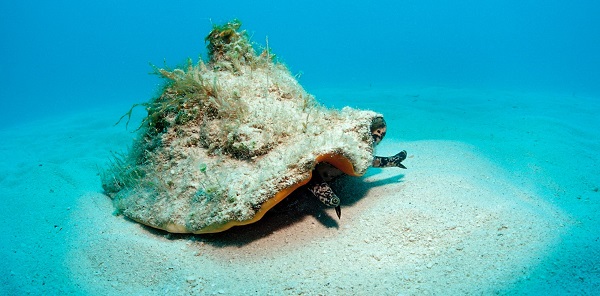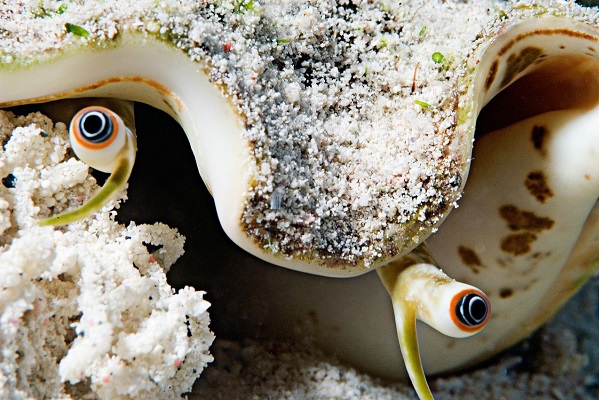Cynthia Barnett (Atlas Oscura, Hakai Journal) writes concerning the area’s first and solely locally-run hatchery— Naguabo Queen Conch Hatchery in Puerto Rico—which supplies a lift for each fishers and the imperiled royal sea snail.
[Many thanks to Mary Ann Gosser Esquilín for sharing the link to the video below of “Tour of the Naguabo Queen Conch Hatchery in Puerto Rico” by the FAU Harbor Branch Oceanographic Institute.] See excerpts from Barnett’s article under:
AS THE BLUE-AND-WHITE SKIFF CUTS throughout the bay to Naguabo on the japanese tip of Puerto Rico, fisherman Gabriel Ramos is the primary to come back into focus, waving his arm in pleasure. The nearer the boat skips to shore, the extra particulars emerge: dive tanks clanking within the hull, gaffs for catching pulpo (octopus), spearguns for pargos (snappers). Solely on the dock does the day’s haul grow to be seen, in two buckets on the backside of the boat. One is crammed with slabs of carrucho—queen conch. Carrucho is a prized catch. Promoting for US $14 per pound, it’s the priciest merchandise within the fish markets alongside El Malecón de Naguabo, the close by waterfront promenade recognized for recent seafood.
Right this moment’s conch prize, nevertheless, just isn’t the sliced white flesh heaped within the first bucket. Ramos is pumped about what appears like a clump of shelly sand, sealed in a sandwich bag and floating in seawater on the backside of the second bucket. It’s a string of conch eggs.
A mom queen conch lays half one million eggs over a day or so in a gelatinous strand that, unfurled, would stretch longer than a semitruck trailer. She camouflages the strand with sand as she goes, fussing it right into a tidy pile that might cross for a little bit of coral or shell. Laying 9 or so plenty every season, she’s going to ship almost 5 million larval conchs a yr into the ocean. Fewer than one % will survive to develop into the Caribbean’s favourite marine snail, with the shiny pink shell and candy meat eaten throughout the 26 nations in its vary.
A queen conch shell can develop as massive as a soccer. Its handle-like cavity offers it a equally satisfying grip, although it weighs nearer to a brick. That heft makes queen conchs simple to identify and catch—really easy that overharvesting for his or her meat and shells has collapsed populations all through their habitat within the Caribbean Sea and Gulf of Mexico. America was the primary to lose its queens, which as soon as thrived on the southern tip of Florida. They haven’t rebounded regardless of Florida’s ban on business conch fishing since 1975 and all harvesting since 1986. After the state ban, the large sea snails had been listed underneath the Conference on Worldwide Commerce in Endangered Species of Wild Fauna and Flora to watch and restrict commerce. The losses have solely hastened. Scientists have warned that the once-massive conch herds of The Bahamas—which exports almost all of the conch meat consumed in the US—have now thinned under the minimal quantity wanted for the animals to breed.
Saving the species will take daring actions, scientists say, from shrinking the harvest to defending larger swaths of the seagrass beds the place conchs collect in herds to graze and breed. That’s no much less true in Puerto Rico, the place the animals are in decline however barely higher protected than in The Bahamas—with a closed season every summer time to permit the conchs to breed. Ramos represents one other key piece too typically lacking from the conservation puzzle: giving the fishers a severe position in restoration efforts, and compensating them for that work identical to each different professional concerned.
Ramos, certainly one of an estimated 800 fishers in Puerto Rico who dive for carrucho as a essential supply of revenue, is a part of this new reciprocal mannequin that pays him extra for accumulating eggs than he earns from harvesting conch. Scuba diving over a patch of seagrass this morning in about 15 meters of water, Ramos grabbed a stay queen conch—destined for market till he noticed that it was a breeding mom. A sandy egg pile lay beneath her shell. As an alternative of slicing out the carrucho meat along with his knife, Ramos teased out 1 / 4 of the egg mass along with his fingers, slipped it into the sandwich bag, and returned the conch to her remaining sea-bottom brood.
On the dock, nonetheless clad in his wetsuit, Ramos arms up the bucket with the conch eggs as if it holds a donated organ on its solution to a transplant. Conservation biologist Raimundo Espinoza grabs the bucket and carries it into an getting older dockside constructing. The 2-story advanced is dwelling to the Naguabo Fishing Affiliation, certainly one of about 40 public-private fishing cooperatives in Puerto Rico that assist members by shopping for and advertising their seafood. Naguabo’s is likely one of the island’s oldest fishing co-ops, based greater than half a century in the past by the grandfathers of a number of the fishermen who belong to it right this moment.
Elements of the advanced and dock are oddly twisted or lacking—reminders of Hurricane Maria’s direct hit in 2017 and the danger of future storms. However behind their repaired seafood market and gear-storage lockers, members of the affiliation have responded to the hurricane with an addition their grandfathers may not have imagined: a hatchery for rising their very own queen conchs.
Half indoor lab, half open-air courtyard, the Naguabo Queen Conch Hatchery burbles in an orderly community of pipes and filters, deep tanks and shallow basins, beakers and carboys swirling with algae. Within the lab, Ramos and Espinoza peer by means of a microscope at sections of the egg strand underneath the eager eye of Megan Davis, a marine analysis professor at Florida Atlantic College (FAU) Harbor Department Oceanographic Institute who designed the hatchery and oversaw its building by the fishers in 2021. Funded by the Nationwide Oceanic and Atmospheric Administration (NOAA) Fisheries’ Saltonstall-Kennedy grant program that helps fishing and marine aquaculture, the hatchery is a partnership among the many fishing affiliation; Davis’s queen conch lab at FAU; and Conservación ConCiencia, a Puerto Rico–primarily based NGO based by Espinoza to deal with poverty as a method to long-term marine conservation. [. . .]
For full article, see https://www.atlasobscura.com/articles/queen-conch-puerto-rico and https://hakaimagazine.com/options/the-queen-conchs-gambit/

